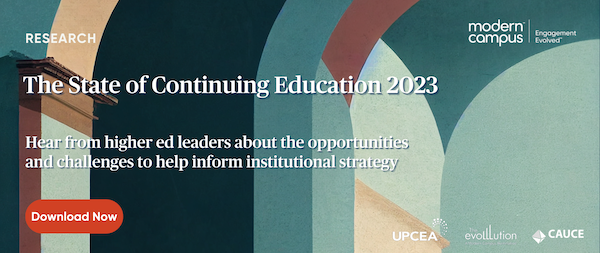Published on
Identifying Opportunities to Best Serve the Modern Learner

As Continuing Education gains more attention for work with nontraditional learners, institutional departments need to come together to create a seamless partnership across the institution. This partnership sets up the institution to serve the modern learner. In this interview, Enrique Infanzon discusses why CE has typically sat outside the institution, how Miami Dade College collaborates with its CE unit and the opportunities institution-wide collaboration could bring about.
The EvoLLLution (Evo): Why have CE units historically been siloed?
Enrique Infanzon (EI): Looking at the history of higher ed, Continuing Education became the focus to level up the population. It’s there to help people acquire a set of skills they don’t have, retrain to take a different career path or keep up with industry, more and more as those services have become more valuable over time.
In the last few years, the value of transferable skills has come from the need for stackable credentials. We’re beginning to blur the line between credit and noncredit by using professional development to create pathways between the two sides and allow someone to upskill throughout their career. People can get the skills they need for a job, then work while continuing a college program.
Blurring the line between credit and non-credit is the future. Those stackable credentials have begun to move CE out of their silos and into the broader conversation.
Evo: What key qualities make a CE unit stand out?
EI: Luckily for Miami Dade College, our CE unit isn’t siloed. We’re at the center of every conversation, which allows us to onboard nontraditional students into credit programs and help them take that credit path. Then we have credit students who come back and level up. What makes us special as Continuing Ed providers is that we’re very innovative in practice. We’re on top of industry needs and train the workforce to till talent gaps.
The speed to delivery is another thing that makes us stand out. We can go from ideation to program development to launch in a very short time. CE can be the sandbox of innovation for the College—the opportunities are endless. So, when the larger college wants to get into a specific field, CE can help them understand market demand.
CE also attracts the nontraditional student the college didn’t see as an opportunity. These students can then take a noncredit course and embark on a pathway leading to a credit program. We serve as a low barrier to enter college that blurs the lines between the institution’s two sides.
Evo: What are some challenges that come with CE units sitting outside the institution?
EI: That type of disconnect doesn’t allow CE to support the college’s strategic priorities. We see that the connection positively impacts our community because we’re able to understand the student body’s needs. We can also help the college in areas no one else can.
Being siloed only makes them function inefficiently. As time progresses, if you’re in that silo, then the college and community won’t understand what CE does. At Miami Dade, people understand what CE does and know they can come to us for help. They know the students we’re bringing in, where we can step in and provide connections.
Evo: What are some best practices to eliminating silos across campus?
EI: CE folks need to see their jobs as a sales job—you have to sell in and out. The institution needs to know and understand what you bring to the table. So, must give our value proposition, whether that’s speed, innovation, pricing, revenue, etc. CE is set up differently, but what value does it bring to the institution and partnership?
The second is for the institution’s leaders to understand how to leverage CE. We’re lucky that our president and provost both see how CE’s role and the future of the college come together to serve the community. From the CE employee perspective, it’s a constant recruitment and sales job. It’s also important from the credit side to see what their concerns are. For them, things are very rigorous in the classroom and with faculty credentials. For us, we’ve imitated a lot of those practices into our CE units. There’s innovation on both sides.
Evo: How can CE units leverage their uniqueness to better position the institution as a whole for success?
EI: Being available and ready to partner is key. We have this mentality that if we see a project and know we can help, we’ll always go for it. Getting involved with what’s happening in the college breaks down the silos on both sides. That ability to go from idea to action in a short time is critical to addressing community or industry needs quickly.
With the Miami Tech movement, we created professional development. And on the college side, we created pathways for emerging techs to train people to enter the workforce in an accelerated way. We’ve also seen increasing immigration in Miami-Dade County, so we’ve created English programs to get these learners into the workforce. We have the uniqueness to go into multiple areas—from technology to business to logistics. We have a wide spectrum of programs that can accelerate these English learners in the industry. Speed while maintaining quality is key.
Evo: Is there anything you’d like to add?
EI: We’re continuing to see this focus on CE as more consumers and colleges are seeing its value. We’re very lucky at Miami Dade to have found that value and understand it. As we move forward, there will be more individuals coming into the college through nontraditional paths and moving into a credit program. It’s our job to help them make that seamless transition.
This interview was edited for length and clarity.

Author Perspective: Administrator



